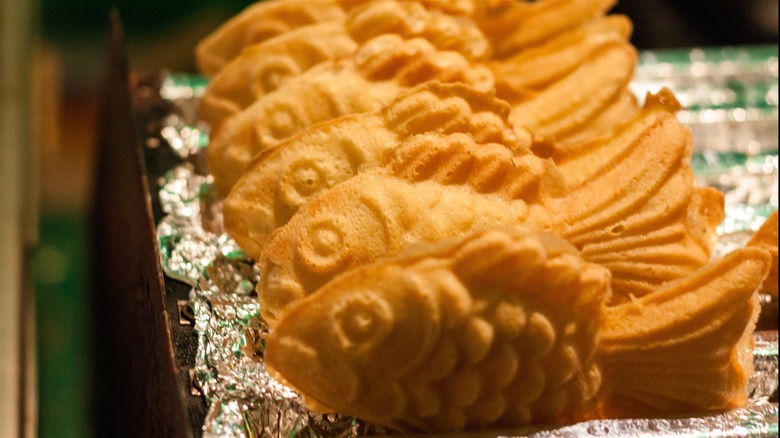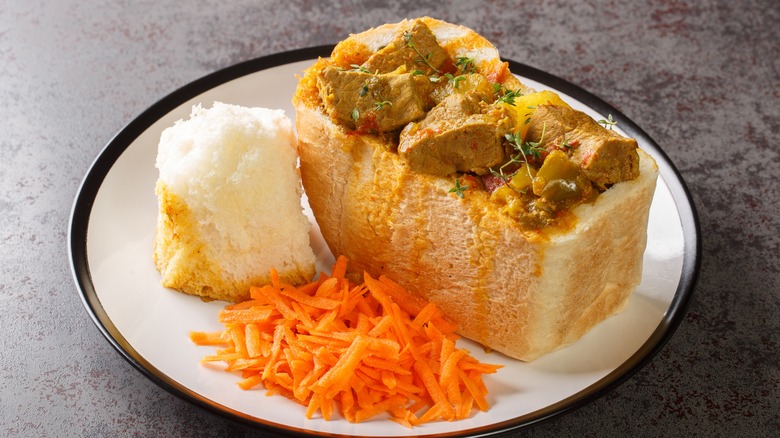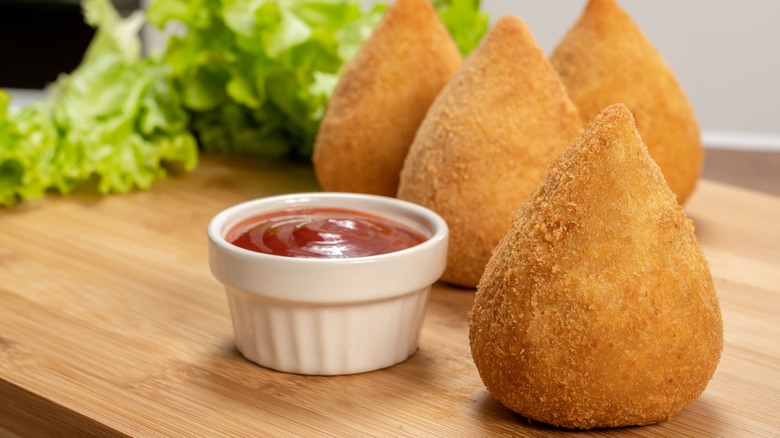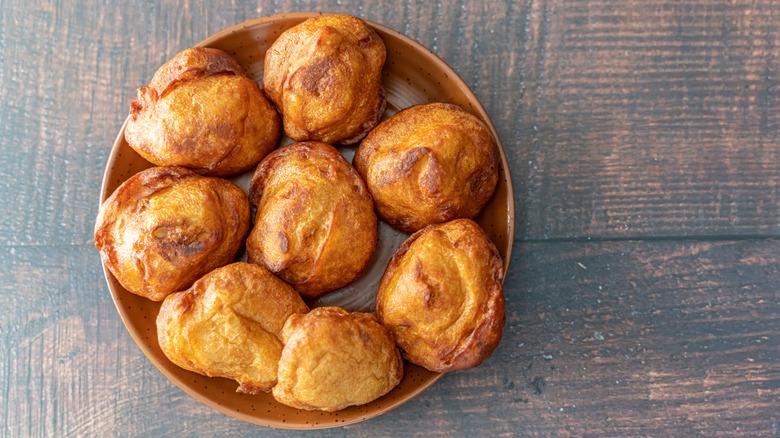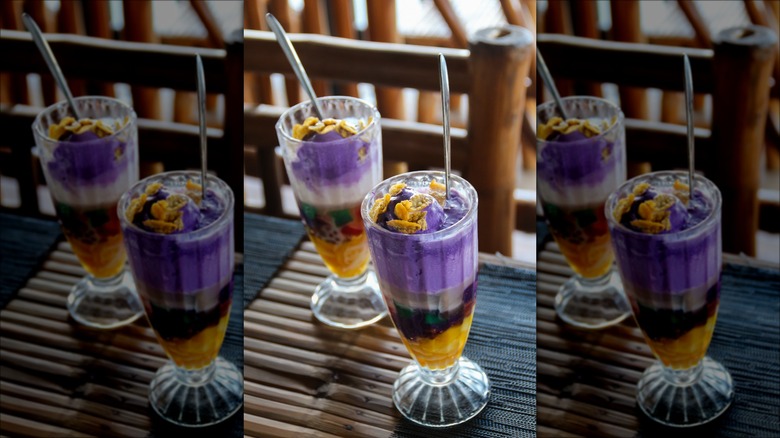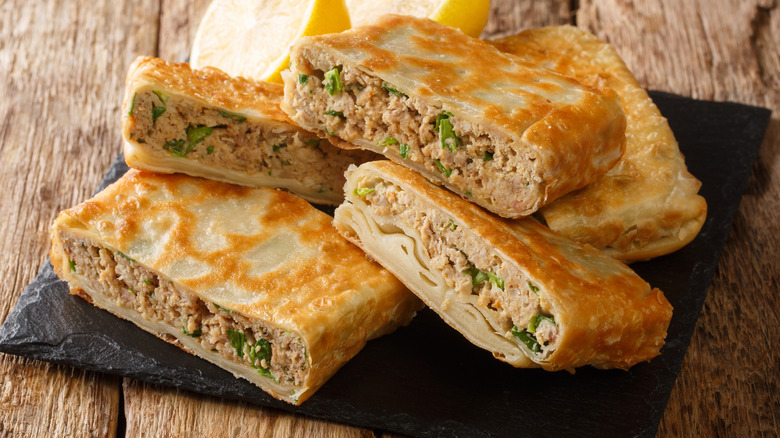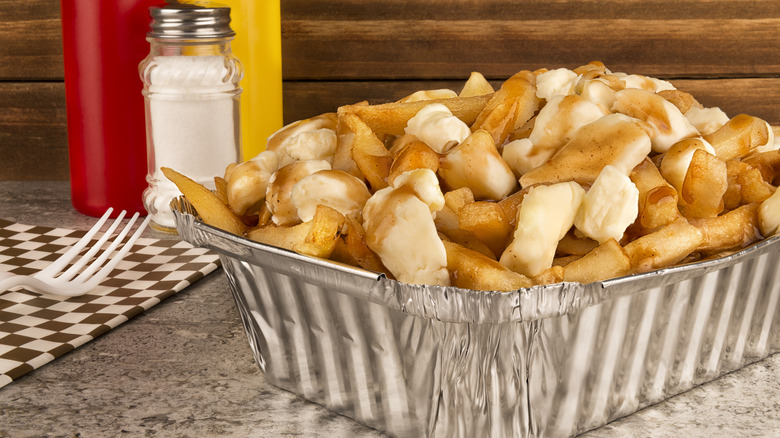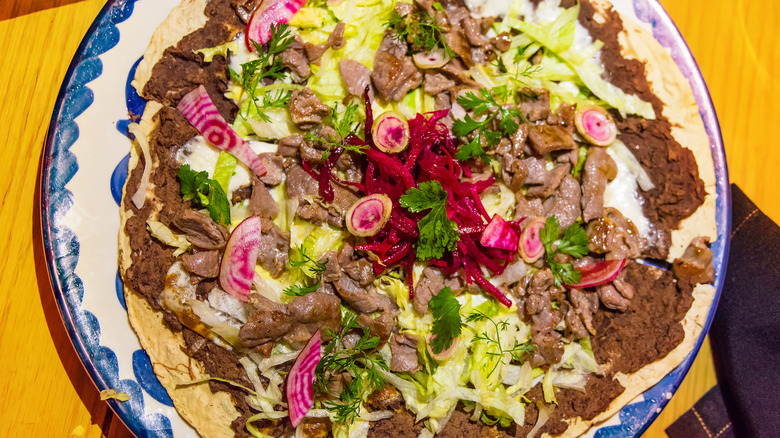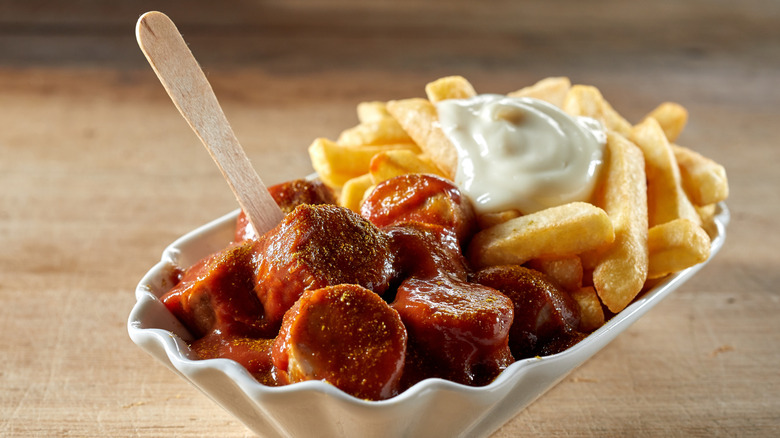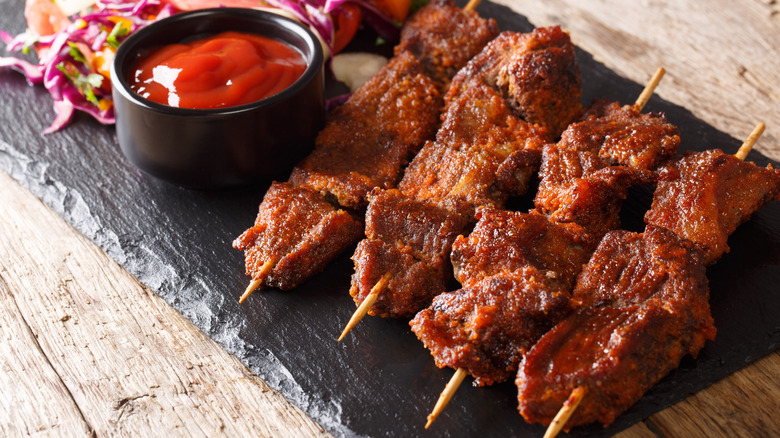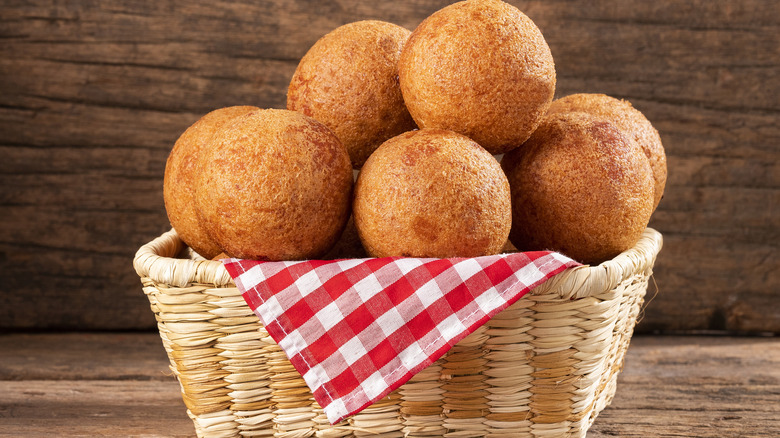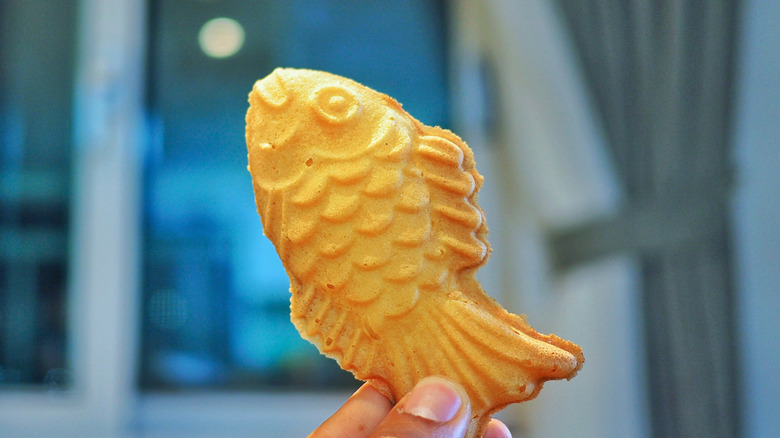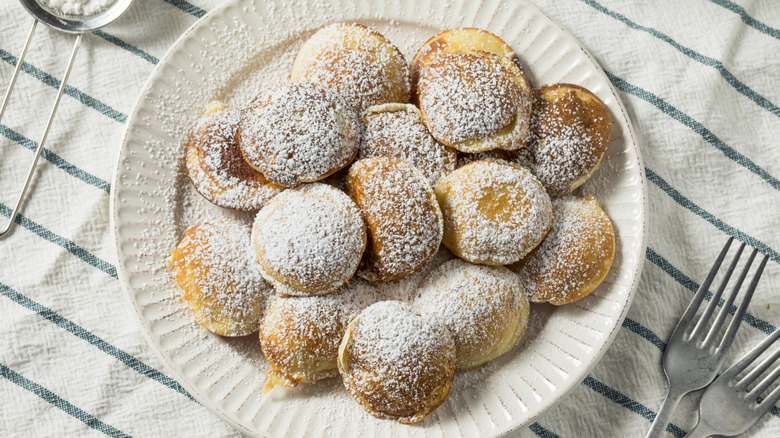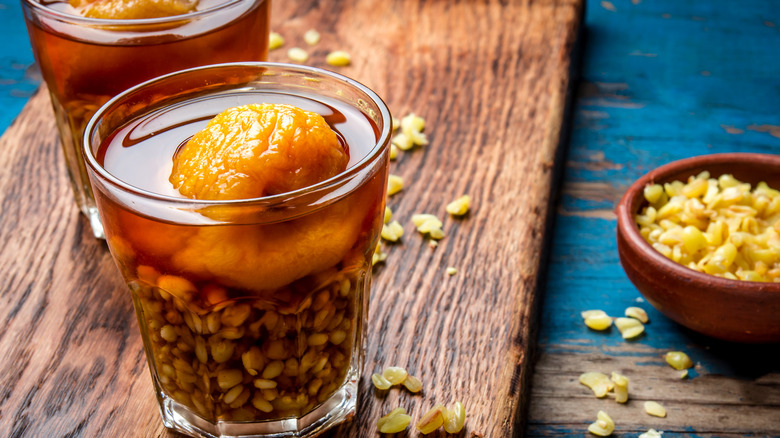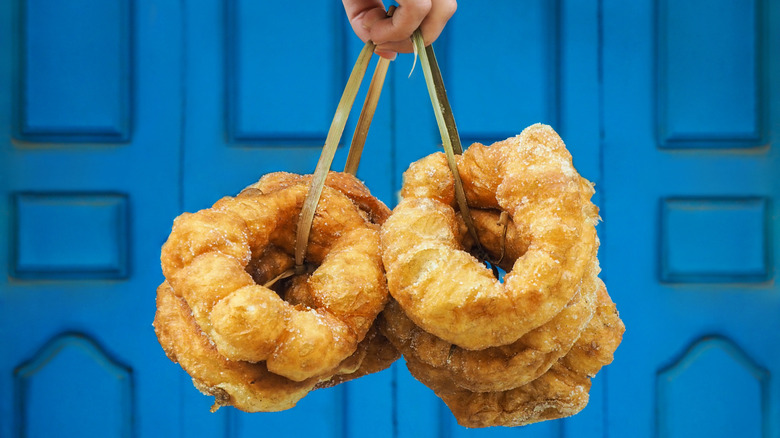Street Foods We Wish Were Common In America
One of the greatest joys of going to a new city is taking a culinary tour of the local street food. The variety, flavor, affordability, and settings cannot be outdone, and it's easy to spend an entire vacation eating exclusively from stalls on busy city streets. In this respect, Americans are spoiled for choice. From soft pretzels and lobster rolls to tacos and Philly cheesesteaks, we have some of the best street foods right here in the U.S.
Sadly, however, some al fresco delicacies have yet to reach our shores. Around the world, vibrant street food scenes abound, and we have to travel to get a taste of what they're all about. From the iconic foods you can only find in Asia to the myriad of mouth-watering options across Africa, Europe, and Central and South America, many of us don't even know what we're missing. Keep reading to discover some of the most delicious street foods from around the world that will have you packing your bags for an international trip before you can say "poffertjes."
Bunny Chow - South Africa
It may sound like a crime against one of the world's cutest mammals, but bunny chow has nothing to do with rabbits. It's a hollowed-out quarter loaf of white bread filled with curry. Mutton and chicken are common options, but there are vegetarian variations as well. Bunny chow was invented by the Indian community in the South African city of Durban in the mid-20th century, and the word likely comes from their class name "Bania."
During the official period of racial segregation from 1948 to the 1990s, bunny chow was a go-to meal for Black and Indian South Africans who were barred from most restaurants and forced to eat on the go. Now, the dish is enjoyed throughout the country. Eating it with your hands is even messier than eating a New York hot dog while blindfolded, but it's mandatory if you want to avoid looking like an uninitiated tourist. No matter what you're wearing, though, the sauce-soaked white bread is so delicious that you'll forgive the inevitable stains it leaves.
Coxinha - Brazil
You can find Brazilian food all over the U.S., from açai bowls to churrascaria steakhouses. One food that you're less likely to find, however, are coxinhas. Shaped like raindrops, these doughy parcels of meat are a masterclass in texture. From the crispy outer layer, gooey dough, and perfectly seasoned meat filling, it's the perfect, palm-sized snack when you're headed to the beach or in need of a quick, pre-dinner bite after work. Fried dough makes just about anything taste better, but the filling is what stands out. The most common version uses finely shredded chicken, cream cheese, and spices to form something resembling a paste, while the dough sometimes contains potatoes to add to the doughy starchiness.
The origins of the snack are murky, but many believe that coxinhas were invented in 19th century São Paulo. Originally made by dipping chicken drumsticks in batter and frying them, coxinhas are now a beloved street food throughout the country with many variations on the classic shredded chicken filling, from corn to heart of palm to just plain cheese. Easy to make and even easier to eat, it's a mystery why coxinhas aren't ubiquitous in the U.S.
Accara - Senegal
Although they are often compared to falafel, Senegalese accara deserve to be considered on their own terms. The black-eyed pea fritters have more moisture and a strong bean flavor when compared to the Middle Eastern snack, and are often paired with a spicy pepper sauce called kani. They hold a beloved and meaningful place in West African culture. In Senegal, nyebe (black-eyed peas) symbolizes prosperity and good luck. Nyebe salads and stews are popular, but if you walk through the streets of Dakar, you're more likely to see vendors selling accara, either with kani or in a baguette.
You can find black-eyed pea fritters throughout West Africa, including in Nigeria, where they're called akara. Farther afield, you can find a version of the dish in Northern Brazil. Acarajé is one of the most common street foods in the state of Bahia, brought to the country by West Africans during the transatlantic slave trade. The recipes are similar, but in Brazil, the fritters are halved and stuffed with shrimp stew called vatapá. Though these variations are delicious, the simplicity of Senegalese accara let the delicate flavor of black-eyed peas shine, and offers a mouth-watering alternative to tater tots and falafel.
Halo-Halo - Philippines
The Filipino street food called halo-halo is unlike anything you'll find in the U.S. Bursting with color, texture, and unfamiliar ingredients, it's a must-try treat on a trip to the Philippines and would be a welcome addition to the U.S. Like a Starbucks Frappuccino, halo-halo is an icy, sweet confection that is difficult to categorize, and comes in just about every flavor you can imagine. The basic ingredients are shaved ice, ube ice cream (made from purple tubers similar to sweet potatoes), and colorful sweets. Common additions include mango or jackfruit jelly, macapuno (a variety of gelatinous coconut), tapioca pearls, and flan.
Halo-halo, which means "mix-mix" in Tagalog, is the tonic to take the edge off a humid summer day. With its bright colors, a riot of flavors, and variety of textures, it will fulfill your nostalgia for playful childhood desserts and your adventurous palate. Try halo-halo and you'll never want to settle for a run-of-the-mill ice cream Sunday again.
Martabak - Indonesia
Martabak (also spelled "murtabak" and "muttabaq") is a street food beloved throughout Southeast Asia and the Middle East. Given its widespread popularity and easy appeal, it's difficult to comprehend why it hasn't taken off in the United States. Meaning "folded" in Arabic, it's made of paper-thin dough that is filled with meat, eggs, and other ingredients. It bears a small resemblance to quesadillas and samosas, but uses thinner dough than quesadillas and is not deep-fried like samosas.
In Indonesia, these folded parcels are made by stretching the thin dough onto a hot skillet of oil, and adding duck eggs, ground chicken, and green onions as it fries. It is then folded like a blanket, cut into squares, and served with pickled vegetables and spicy chilies. In Yemen, the fillings are usually egg or cheese, while in Singapore, there are whole restaurants dedicated to the street food that offer a plethora of options, from sardine with curry sauce to mutton and cheese.
Poutine - Canada
If Québec had a national dish, it would almost certainly be poutine. The combination of fries covered in cheese curds and drenched in gravy has proven to be a snack so addictive in the province that it can be found in gourmet restaurants and food stalls alike. Invented in the 1950s in a snack bar in a rural part of the province, the dish is relatively recent considering its outsized role in Québécois identity. Its name comes from the slang word for "mess," and for decades, the food was viewed as lowly and inelegant by the rest of Canada. Fast-forward to today, and it has become something of a national mascot. When Prime Minister Justin Trudeau paid a visit to the White House in 2016, he was served smoked duck poutine canapés. During the press tour of the 2018 movie "Crazy Rich Asians," one of Québec's most popular poutine purveyors created a "crazy rich" version of the dish that included gold leaf, edible orchids, wagyu steak, lobster, and caviar for an eye-watering CAD $448.17.
American eaters don't need a deluxe version of poutine to fill the inexplicable gap in the street food market. All we're asking for is for the dish to migrate south of the border, and become as commonplace as hot dogs and tacos. Squeaky cheese curds, a generous pour of gravy, and fresh-cut fries will do the trick.
Tlayudas - Mexico
Americans are lucky enough to have freshly made Mexican food in many parts of the country, but for some reason, tlayudas are few and far between. The street food hailing from the southern state of Oaxaca has everything going for it. It's cheesy, crunchy, salty, and full of flavor. It looks a little like a pizza but, if we're being honest, is even tastier.
Oaxacan cuisine is unlike any other. The state is made up of desert, mountains, and paradisal beaches, and is home to at least 18 ethnic groups. This geographical and cultural tapestry has created an abundance of foods specific to the various regions within the state. Made on a broad, durable tortilla that's crunchier than it is flexible, a tlayuda consists of asiento (the fatty run-off from a pan of carnitas), queso fresco, beans, and meat. The meat is usually either chorizo, tasajo (thinly sliced beef), or cecina (chile-rubbed pork). Radishes, tomatoes, avocados, and cucumbers are common additions.
Like all the best street foods, the flavor comes down to the authenticity of the ingredients and the practiced ease of preparation. Without the particular starchy mega-tortillas, asiento, and meat, it is difficult to recreate this miracle of a dish at home to make up for its scarcity in the U.S., but it might inspire you to take a trip to the south of Mexico.
Currywurst - Germany
Germany isn't known for its major contributions to global cuisine, but in the case of currywurst, it should be. Created in Berlin in 1949 by local restaurant owner Herta Heuwer, it was reportedly an attempt to spice up the dismal food that was on offer in the post-war years. Heuwer bartered with British soldiers for ketchup and curry powder in exchange for alcohol, and within a decade, had opened a successful street stand, created a signature sauce, and patented it. Some claim currywurst was actually invented in Hamburg, while others argue it was in the western Ruhr region. Either way, it remains most closely associated with Berlin, where vendors selling the spicy sausages can be found on almost every street corner.
Currywurst is usually sold in cardboard trays with fries, with the option to have it "mit darm" or "ohne darm" (with casing or without). When the dish was created, Berlin was split between East and West, and the former did not have access to sausage casing. Nowadays, many vendors on the East side of the city still use sausages without casing, despite the decades that have elapsed since the fall of the Berlin Wall. Regardless of which side you fall on, it's hard to resist the unlikely combination of ketchup, curry spices, and fatty sausage.
Suya - Nigeria
In Nigeria, suya is the street food to satisfy all your needs. It's filling, portable, and oh-so-delicious, and we're just waiting around for it to make its way to America. It appears simple enough: thin slices of flame-grilled steak on skewers. But it isn't just any steak. The flavor comes from the yaji marinade, which includes ground peanuts, ginger, garlic, and paprika. It's crispy, juicy, and chock full of flavors that you wouldn't expect to find in the same mouthful.
Suya is thought to have originated in the north of the country, a place known for its mastery of meat. Over time, it migrated South, thanks to the pastoral nomads called mallams who brought their craft to cities and towns throughout the country. Unlike many popular street foods around the world, suya remains proudly rooted in the hustle and bustle of city life, and is rarely found on restaurant menus, formal or casual. Whether you're a tourist, businessperson, or construction worker, suya stalls are a fixture of daily life in Nigeria, and one of the best ways to fill an empty stomach.
Buñuelos - Colombia
Not to be confused with flat, crispy Mexican-style buñuelos, Colombian buñuelos are fried balls of cheesy dough with just a hint of sweetness. Tradition relegates them to Christmas time, but they're so delicious that you'll want to eat them year-round. The doughy treats came to Latin America with the Spanish, who devised their buñuelos recipes with spices dating back to the Muslim rule of the country. Across Latin America, variations abound. Mexico's flat discs are sweet and crunchy, while in Cuba, the dessert is shaped into a figure-eight and doused in a syrup made of citrus, anise, and cinnamon.
All these versions are delicious, but Colombian buñuelos deserve special mention for their disguised complexity. They may look like average donut holes, but they're less sweet. The dough might look like a straightforward concoction of white flour, but it's made of yuca and cornstarch to produce its smooth texture. The addition of cheese gives buñuelos a dense, silky mouthfeel, while the use of brown rather than white sugar adds an unexpected hint of caramel. Overall, Colombian buñuelos are exactly the kind of warm treat you're craving during the winter, whether you're baking at home or looking for a quick, comforting bite while holiday shopping.
Bungeoppang - South Korea
Bungeoppang holds a special place in many Koreans' hearts and is a favorite of visitors. Sold in the fall and winter, the small pastries are shaped like fish. While the shape and name (which means "carp bread") suggest a savory seafood snack, bungeoppang are traditionally filled with sweetened red bean paste. The batter is cooked in fish-shaped molds, and the resulting pastry is similar to a waffle. The snack resembles the Japanese street food taiyaki, which is also shaped like a fish, but the latter is modeled off a sea bream, and comes with a variety of sweet and savory fillings.
Bungeoppang has been a staple of winter streets in Korea since the 1930s, and is a nostalgic snack for many Koreans. In recent years, however, the number of vendors has been in decline. As the food became more scarce, faithful eaters were in such a panic that an app was created to show people where the nearest stall could be found, and sales of bungeoppang batter for home baking began to rise. This doesn't bode well for the bungeoppang industry outside Korea, but we're still holding out hope.
Poffertjes - Netherlands
Many parts of the world have discovered the chewy, syrupy goodness of Dutch stroopwafels but have somehow missed out on the marvel that is poffertjes (pronounced "poh-fur-chess"). These tiny pancakes covered in powdered sugar and a dab of melting butter are popular in outdoor food markets in the Netherlands, especially Amsterdam, where they vie for position amongst stroopwafel vendors and pannenkoeken stalls. Unlike Dutch pancakes, however, poffertjes are yeasted and made with buckwheat flour, giving them a springy, airy texture and earthy flavor.
The bite-sized treat dates back at least to the 1700s when a recipe first appeared in print, but it is believed that they were once used to substitute the communion host. The use of buckwheat was likely a necessity rather than a choice, as the crop was known as a poor man's grain. Some recipes now call for pure wheat flour, but traditional poffertjes still use buckwheat. Interestingly, the small, yeasted pancakes were popular in parts of the U.S. when Dutch settlers arrived, but you're unlikely to find them now unless you're lucky enough to have a poffertjes iron, and regularly make them yourself.
Mote con Huesillo - Chile
During the summer months in Chile, no drink hits the spot quite like mote con huesillo. Half beverage, half dessert, it's made from dried peaches, wheat berries, and spiced syrup. To make this drink, whole, dried peaches are soaked overnight before being stewed in sugar syrup. Because they're dried to begin with, they can soak up plenty of sugary moisture while retaining their structure. The syrup is often infused with cinnamon and sometimes orange peel. Honey is sometimes used as a sweetener, but chancaca, a dark, caramelly unrefined sugar found in Peru, Bolivia, and Chile is traditional. Once the syrup has cooled, it is poured into a cup with the rehydrated peach and cooked wheat berries.
Mote con huesillo is an unusual street food. Though it is frequently compared to bubble tea, its use of wheat berries rather than tapioca pearls gives it a distinctive, grain-like flavor that tempers the sweetness of the sugary peach syrup. It might take some getting used to, but mote con huesillo is surprisingly addictive, and the perfect drink during a hot summer's day of sightseeing or hiking.
Sfenj - Morocco
Sfenj is a pastry named after the Arabic word "isfejen," meaning "sponge." These round pastries can be found throughout the Middle East, particularly in Morocco, where street vendors prepare them to order in front of customers. Tubs of yeasted dough leaven, before being portioned into rings, and tossed into a vat of hot oil. The fried pastries resemble donuts, but are less sweet and have a crunchier, deep-fried exterior. The dough is a simple mixture of flour, yeast, and water, making them less cakey than American-style donuts that frequently include eggs or milk. There is no wrong time to eat sfenj, but many Moroccans eat them for breakfast or alongside mint tea in the afternoon. They are often sweetened with powdered sugar, honey, or orange-flavored syrup, though some people prefer to eat them plain.
The pastry holds particular significance for Moroccan Jews, who eat it alongside other fried foods during Hanukkah. Known as the "Festival of Lights," the holiday commemorates the oil that burned for a miraculous eight days in the Holy Temple in Jerusalem where the Maccabean Jews celebrated their successful revolt against the Assyrians. Moroccan Jews introduced this street food to Israel in the 1950s, but it is now largely relegated to street stalls in Northern Africa, and occasionally in Hanukkah celebrations throughout the world.
